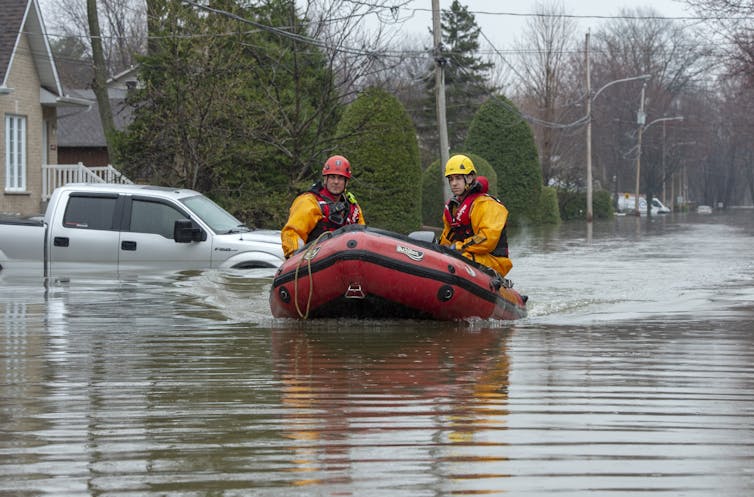François Brissette, École de technologie supérieure (ÉTS) and Annie Poulin, École de technologie supérieure (ÉTS)
The Intergovernmental Panel on Climate Change (IPCC) recently released the first report of the sixth assessment cycle. Three others will follow in 2022.
This volume of nearly 4,000 pages has observations on climate change from the past 150 years and projections for climate change up to the end of this century. It is being published 31 years after the first assessment cycle and eight years after the fifth assessment cycle.
Overall, this latest report does not provide major new insights into climate change or the impact of human activity on it. It does, however, improve our understanding of the human role in climate change and reduce uncertainty about anticipated future impacts. By refining observation methods and improving the accuracy of climate models, the report makes it possible to better define the future impacts on the densely populated areas of southern Ontario and Québec.
We are professors of construction engineering and members of the HC3 — Hydrology Climate Climate Change Laboratory at the École de technologie supérieure de Montréal. The laboratory specializes in the study of hydrology, climate and the impact of climate change on water resources.
Warming twice as fast
The average global temperatures on Earth has increased 1.1 C since the pre-industrial era. Climate projections predict a temperature increase between 2 C and 3.5 C by the end of this century. This does not take into account the most pessimistic greenhouse gas emissions scenario, which is now considered improbable by most experts.
Read more: 5 things to watch for in the latest IPCC report on climate science
This warming, however, is not geographically uniform. On the whole, southern Ontario and Québec are warming twice as rapidly as the rest of the world. Northern regions are warming three times as fast.
The faster warming is mainly because of the ice–albedo feedback loop that is linked to the progressive loss of snow cover. This process means, among other things, that solar radiation, which is normally reflected by the snow, will be absorbed instead. We should therefore anticipate an average annual warming of 3 C to 6 C over southern Québec by the end of the century.

However, the warming will not be evenly distributed across the seasons. Winters will warm significantly more than summer. This means future winters will be 4.5-8 C warmer, with less snow cover and a decrease in spring flooding from melting.
Changes in extreme events
Rising temperatures have several other adverse effects, including changes in extreme events. The evidence that these are due to human activity has strengthened since the IPCC’s Fifth Report. It is now well established that human-induced greenhouse gas emissions have led to an overall increase in the frequency and/or intensity of some extreme weather and climate events since the pre-industrial era.
Future projections on a global scale are consistent with this trend. At the regional scale, the magnitude of change varies according to local factors related to changes in land use, such as urbanization or an increase in the area used for agriculture, aerosol emissions into the atmosphere (via industrial activity) and feedback mechanisms, such as ice-albedo feedback.
Read more: Scientists moor ship in Arctic ice for a year to better understand climate change
The report provides little detail about heat waves on a regional scale. That said, for North America, an increase in frequency and intensity is expected by the end of the century. All North American regions will also experience an increase in the intensity and frequency of warm extremes and a decrease in the frequency and intensity of cold extremes.
Rainfall and flooding
The projected increases in rainfall extremes will depend on a number of factors, including the duration of rainfall events and their rarity.
Short-duration rainfall extremes that occur infrequently (once every 10 years or more) will become more intense. But a good portion of the existing water management infrastructure, which has a long life span, will adapt poorly to these increases.
Floods from spring snow melt will likely decrease, due to the decrease in snow cover. But there may be a large increase in “flash floods,” caused by extreme summer and autumn rainfall. These are particularly likely to affect small rural catchments and urbanized areas.

The IPCC analyzed other indicators, including extreme heat, drought and winter conditions. Using these indicators, a number of conclusions can be drawn for southern Ontario and Québec. By the end of the century, the maximum daily temperature could regularly exceed 35 C during the summer months.
Read more: Extreme heat waves are putting lakes and rivers in hot water this summer
Only the most pessimistic emissions scenario points to an increase in the severity of droughts. For the other scenarios, no clear signals emerge, which means further studies are clearly needed.
The snow season is expected to shorten by the end of the century compared to 1995-2014. A shorter frost season is also expected.
Adapting to climate change
Ontario and Québec are warming and are not immune to the effects of anthropogenic climate change.
While efforts to reduce greenhouse gas emissions must be pursued, it is essential to implement adequate adaptation measures to face an uncertain future climate. This first volume of the IPCC’s sixth report mentions the need to strengthen climate services, which is encouraging.
These services are provided by a variety of organizations around the world. They are aimed at providing climate information to support decision-making, by linking science and data production with communication and application by citizens and decision makers. More details will be provided in the second volume of the report.
![]()
François Brissette, Professeur titulaire, groupe de recherche HC3 - Hydrologie Climat & Changements Climatiques, École de technologie supérieure (ÉTS) and Annie Poulin, Professeure titulaire, Groupe de recherche HC3 - Hydrologie Climat & Changement Climatique, École de technologie supérieure (ÉTS)
This article is republished from The Conversation under a Creative Commons license. Read the original article.




